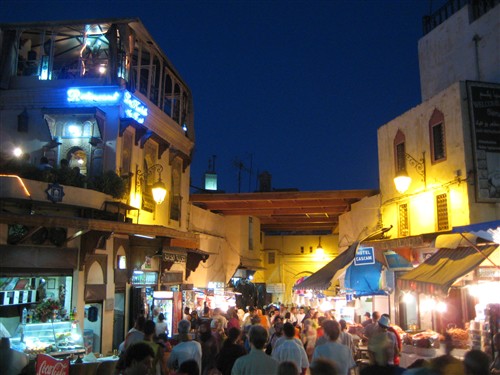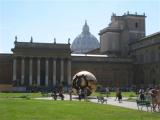Posted under Spain
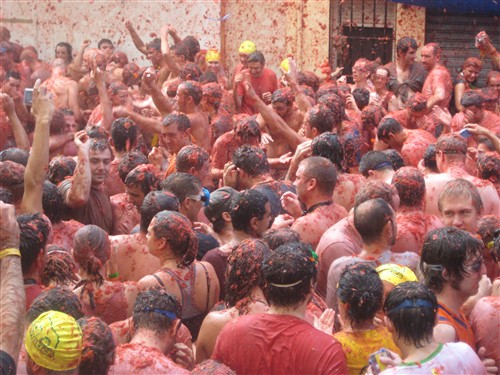
One hundred fifteen thousand kilos of tomatoes dumped into a small town square full of 40,000 drunk people. One hour of mayhem. If I stopped there, you could probably imagine the rest. The actual experience of La Tomatina – the world’s biggest tomato fight – was beyond the scope of my own imagination. So I’ll start from the beginning…
We learned of La Tomatina from our dear friend, Andrew, as the three of us traveled through Egypt almost one year ago. It sounded so crazy that we decided to tailor our Europe itinerary to fit it in. In the early part of our trip, we tirelessly pursued adventure activities – rafting the mighty Zambezi, cage diving with Great White sharks, ambitious hikes, safaris, swimming with dolphins, sailing, kayaking, and scuba diving around the world, just to name a few – but as we returned to Europe to begin our “home stretch”, our mindset had changed. We looked forward to coasting through the comfortable, easy travel of Europe. As the day loomed near, we began to think about the reality of La Tomatina – 40,000 intoxicated twentysomethings in a confined space – and a wave of dread came over us. We tried to disguise it with forced enthusiasm, which appeared as transparent as it was. We know each other too well. But La Tomatina had been booked months in advance so we were going.
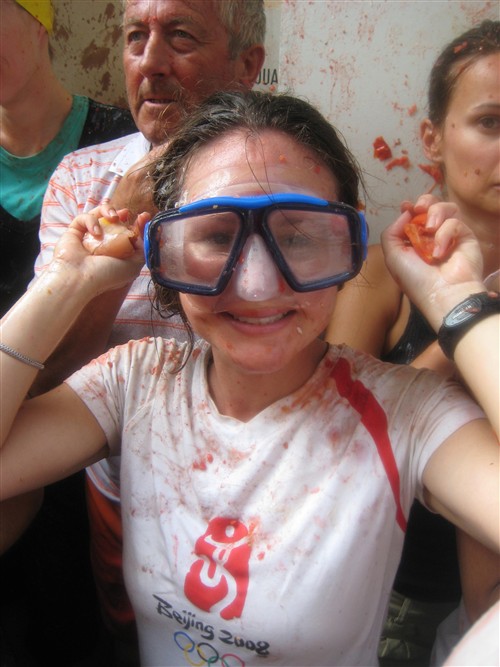 We checked into our three-star hotel in Valencia – the cheapest room we could find during La Tomatina – joking that it was three more stars than we usually get. The tomato fight takes place in Buñol, a town of about 8,000 people, 40 kms away, but Buñol has little in the way of accommodation so everyone stays in Valencia and trains in for the event, with the exception of those who drink all night in Buñol the night before and sleep on the street. That’s not really our style.
We checked into our three-star hotel in Valencia – the cheapest room we could find during La Tomatina – joking that it was three more stars than we usually get. The tomato fight takes place in Buñol, a town of about 8,000 people, 40 kms away, but Buñol has little in the way of accommodation so everyone stays in Valencia and trains in for the event, with the exception of those who drink all night in Buñol the night before and sleep on the street. That’s not really our style.
We rose early on fight day and took the metro to the train station. The metro was already full of raucous revelers, dressed in their worst for the occasion, and seemingly already three sheets to the wind. We followed this same group from the metro to the train station and, with some crafty maneuvering on Aaron’s part, managed to circumvent the queue and get on the first train.
When the train arrived in Buñol, we were among the first wave of revelers to descend upon the town amid the drunken ovation from the enthusiastic campers. The locals were ready for us with the first of many refreshment tents set up just outside the train station. Within ten minutes of our arrival in Buñol, we each had a monster cup of sangria in our hands. What better way is there to truly enjoy a half day among 40,000 drunken college kids than by channeling your twenty-year-old self and drinking sangria at 8am? We couldn’t think of one.
From the station, we had to walk through the town into the old town square, where the festivities would take place. With sloshing sangria we followed the masses downhill through the streets. Many locals had set up beer tents, snack stands with sausages, sandwiches and paella; secure storage facilities, stands selling t-shirts, disposable waterproof cameras and cheap protective eyewear. We had made up sandwiches that morning and had our scuba masks at the ready. We were fully equipped and wanted a prime spot right in the middle of the action. When we reached the square, it was already crowded but still navigable. We planted ourselves in the center and took in the hysteria in our midst. The surrounding buildings were draped with plastic tarps. Groups of people had coordinated costumes: guys in matching flamenco aprons, girls in swim caps and fluorescent tutus, a lot of white shirts and swimwear. The crowd had a rowdy, good-spirited energy but a lot of people were already wasted with two hours still to go before tomato time.
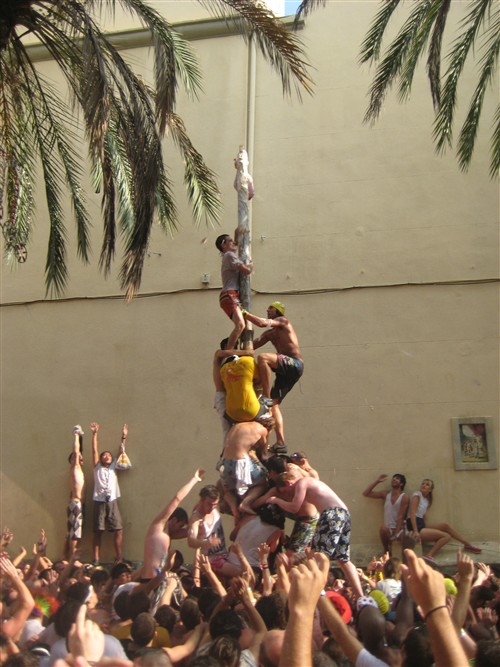 The ham pole went up around nine. An integral part of the annual tomato fight, a telephone pole with a ham leg tied to the top is fastened into the ground. The pole is slathered from top to bottom with a thick layer of what looked like animal lard but smelled more like soap. Per tradition, the crowd must climb the pole and cut down the ham before the tomato fight can begin. With two hours and a little coordination, that should be no problem, I thought to myself. Wrong!
The ham pole went up around nine. An integral part of the annual tomato fight, a telephone pole with a ham leg tied to the top is fastened into the ground. The pole is slathered from top to bottom with a thick layer of what looked like animal lard but smelled more like soap. Per tradition, the crowd must climb the pole and cut down the ham before the tomato fight can begin. With two hours and a little coordination, that should be no problem, I thought to myself. Wrong!
What ensued over the next two hours was utter chaos, a comedy of blunders, as drunken imbeciles climbed all over each other in pursuit not of the ham but of their own two seconds of glory, of being photographed on the pole before their chauvinistic idiocy brought the pile to the ground. For the first hour, it was hilarious, then gradually digressed to merely funny, then mildly entertaining, then painful to watch. The redeeming quality of the ham pole debacle was a guy in a fuzzy yellow chicken suit who repeatedly took to the pole while the riled crowd chanted, “Chicken! Chicken!” Unfortunately, the chicken was way too drunk to make any real progress. By eleven o’clock, the ham still hung mockingly from atop the pole but the tomatoes came anyway.
The first of five dump trucks rolled slowly into the tiny square as the crowd, roaring with excitement, diverged toward the outer walls to make way. Rowdy locals in the back of the trucks pelted the crowd with tomatoes before the truck dumped its load of bright red ammunition into the square. Bodies scrambled into the truck’s wake and fired tomatoes in all directions. Five minutes later came truck number two, followed shortly thereafter by a third. There were a lot of tomatoes but also a lot of bodies – you had to scavenge for fallen fruit. After the arrival of the fourth truck, however, it was sheer pandemonium! Aaron and I had lost each other in the madness and I was on my own amid drunken flailing limbs in a sea of marinara. There were no friends, no enemies; it was every man for himself and everyone was drenching everyone else with red slop. At one point, I looked down and realized that I couldn’t see my feet – the sauce was ankle deep! By this time, there was hardly a whole tomato to be found. People were scooping up handfuls of sauce and flinging it in every direction. Some sat down in the red sea of sauce, writhing happily while the crowd collectively showered them. Others engaged in drunken group wrestling matches. Countless t-shirts, soaked in salsa, flew through the air. Sauce rained down.
 Thankfully, Aaron and I had established a rendezvous point and found each other again shortly before the bell rang to announce the end of the tomato fight. We were exhilarated, exhausted, and covered in tomato from head to toe. It was caked in my hair, stuck to our clothes, and coming out of our ears. Luckily, our scuba masks had worked perfectly, leaving our eyes the only body part immune from the mess. As the crowd shuffled slowly back uphill toward the train station, the sun which had remained sympathetically hidden behind the clouds all morning, made its glorious entrance and I began to feel the acidity of the tomatoes on my skin. Many good-spirited locals sprayed hoses into the crowd but there were so many people vying for the same sprinkles. We arrived at the train station to find long lines everywhere…long lines for the now disgustingly vile portable toilets, long lines for the makeshift showers, and long lines for the trains. We paid our dues in all three lines over a span of two hours before finally boarding the train back to Valencia.
Thankfully, Aaron and I had established a rendezvous point and found each other again shortly before the bell rang to announce the end of the tomato fight. We were exhilarated, exhausted, and covered in tomato from head to toe. It was caked in my hair, stuck to our clothes, and coming out of our ears. Luckily, our scuba masks had worked perfectly, leaving our eyes the only body part immune from the mess. As the crowd shuffled slowly back uphill toward the train station, the sun which had remained sympathetically hidden behind the clouds all morning, made its glorious entrance and I began to feel the acidity of the tomatoes on my skin. Many good-spirited locals sprayed hoses into the crowd but there were so many people vying for the same sprinkles. We arrived at the train station to find long lines everywhere…long lines for the now disgustingly vile portable toilets, long lines for the makeshift showers, and long lines for the trains. We paid our dues in all three lines over a span of two hours before finally boarding the train back to Valencia.
La Tomatina was an epic adventure. We’d had a ball and were leaving virtually unscathed, which is exactly what I’d prayed for. In an alcohol-fueled melee like that, anything can happen. The mob mentality is always volatile and innocent bystanders can easily become casualties. Our only casualty was the loss of Aaron’s wedding ring, which we realized had slipped off in the showers at the end. A small price to pay for a truly unforgettable experience.
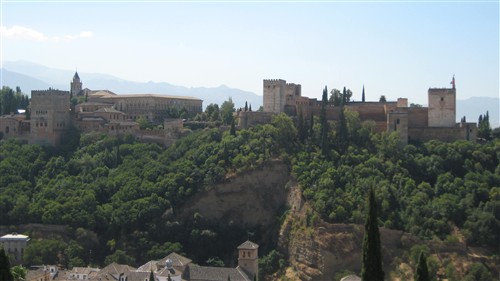
 The palace was exquisite. The rooms were elaborately decorated with mosaic tilework, carved wooden ceilings, molded stucco walls with intricate lace patterns, and traditional Arabic calligraphy. There were picturesque courtyards with manicured gardens, reflecting pools and a labyrinth of covered corridors connecting it all. The design and décor of the Palacio Nazaries was similar to the other medersas and Arab-Islamic palaces that we’ve seen in Morocco and southern Spain but we were awed by it nonetheless. The sheer magnitude of the Alhambra was impressive. The Generalife, or architect’s garden, was a pristinely manicured labyrinth of hedged corridors, arbors, cypress trees, and flowers of every imaginable color. Its magic compelled even the most macho of men to pose giddily for photos among its storybook backdrops.
The palace was exquisite. The rooms were elaborately decorated with mosaic tilework, carved wooden ceilings, molded stucco walls with intricate lace patterns, and traditional Arabic calligraphy. There were picturesque courtyards with manicured gardens, reflecting pools and a labyrinth of covered corridors connecting it all. The design and décor of the Palacio Nazaries was similar to the other medersas and Arab-Islamic palaces that we’ve seen in Morocco and southern Spain but we were awed by it nonetheless. The sheer magnitude of the Alhambra was impressive. The Generalife, or architect’s garden, was a pristinely manicured labyrinth of hedged corridors, arbors, cypress trees, and flowers of every imaginable color. Its magic compelled even the most macho of men to pose giddily for photos among its storybook backdrops. The Albayzin, the old Muslim quarter sprawling up a hill facing the Alhambra, afforded the best views of the fortress-palace. The Albayzin was a maze of narrow alleys meandering within the old stone ramparts. The neighborhood, though largely residential, had lovely plazas with outdoor cafes, small shops selling souvenirs and Moroccan imports, and remnants of mosques-turned-churches. The five kilometer walking tour, winding through zigzagging streets, up and down the hillside, was a great opportunity to stretch our legs and work off some of that gelato.
The Albayzin, the old Muslim quarter sprawling up a hill facing the Alhambra, afforded the best views of the fortress-palace. The Albayzin was a maze of narrow alleys meandering within the old stone ramparts. The neighborhood, though largely residential, had lovely plazas with outdoor cafes, small shops selling souvenirs and Moroccan imports, and remnants of mosques-turned-churches. The five kilometer walking tour, winding through zigzagging streets, up and down the hillside, was a great opportunity to stretch our legs and work off some of that gelato.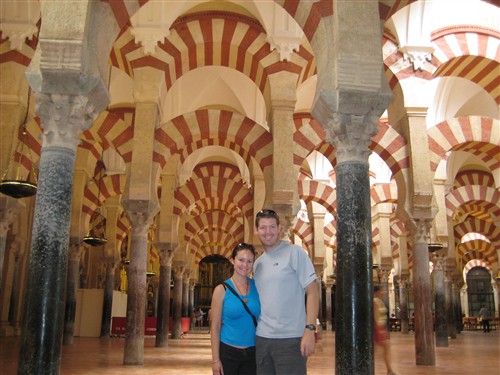
 After a casual lunch at one of the ubiquitous outdoor cafés, we made our way to Cordoba’s most impressive sight – the Mezquita, meaning mosque in Spanish. The Mezquita is also commonly referred to as the Cathedral of Cordoba, which seems contradictory until the story of its current incarnation unfolds.
After a casual lunch at one of the ubiquitous outdoor cafés, we made our way to Cordoba’s most impressive sight – the Mezquita, meaning mosque in Spanish. The Mezquita is also commonly referred to as the Cathedral of Cordoba, which seems contradictory until the story of its current incarnation unfolds.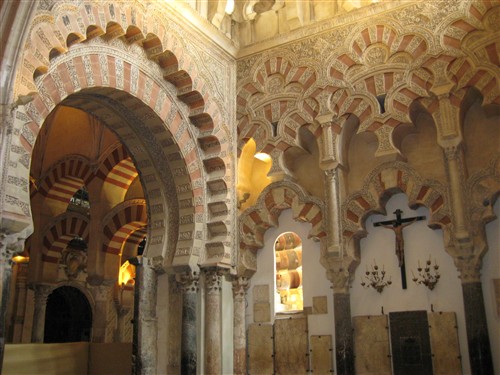
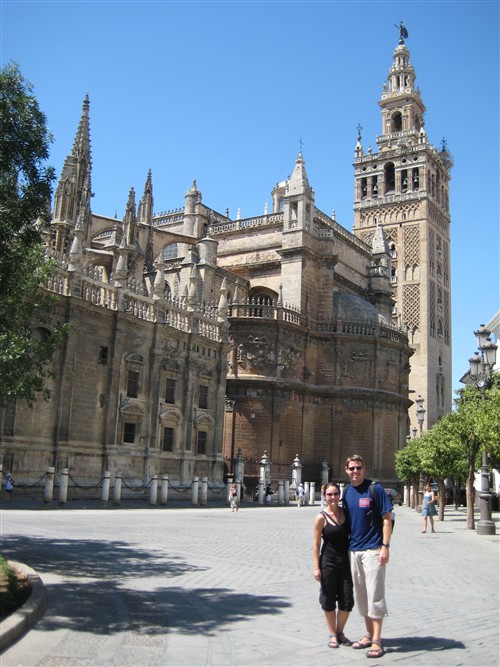 From Tangier, the fast ferry carried us only 35 minutes to Tarifa on the southern coast of Spain but disembarking that ship was like stepping into an old familiar world…and that world was full of boobs! Hooters, knockers, jugs, chi chis…whatever you want to call them, Mediterranean sun-tanned boobs were bulging out of push-up bras, bouncing and jiggling above plunging necklines. After Morocco, it was a bit of a reverse culture shock but we weren’t complaining. Although these were my first steps on Spanish soil, I felt myself thinking, It’s good to be back! Only when you’ve spent time in an ultra-conservative environment, like a Muslim community or perhaps a convent, do you come to truly appreciate the ways that women beautify the earth like bright summer flowers.
From Tangier, the fast ferry carried us only 35 minutes to Tarifa on the southern coast of Spain but disembarking that ship was like stepping into an old familiar world…and that world was full of boobs! Hooters, knockers, jugs, chi chis…whatever you want to call them, Mediterranean sun-tanned boobs were bulging out of push-up bras, bouncing and jiggling above plunging necklines. After Morocco, it was a bit of a reverse culture shock but we weren’t complaining. Although these were my first steps on Spanish soil, I felt myself thinking, It’s good to be back! Only when you’ve spent time in an ultra-conservative environment, like a Muslim community or perhaps a convent, do you come to truly appreciate the ways that women beautify the earth like bright summer flowers.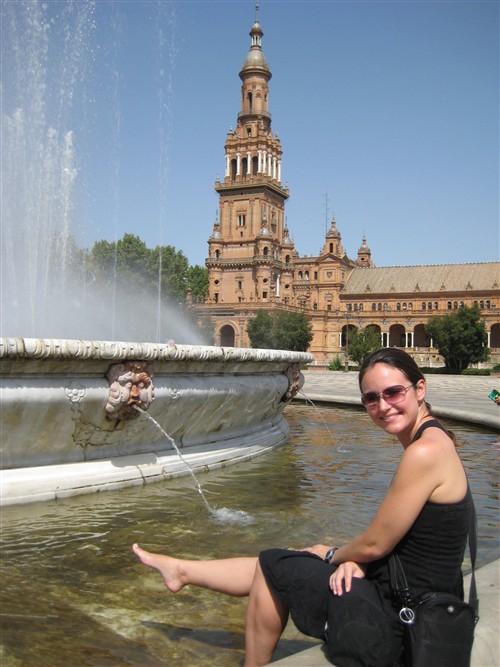 The Alcazar, a palace complex expanded and modified over eleven centuries to suit the tastes of the Muslim and Christian rulers, is a polyglot of Arab-Islamic and European architecture. The main building is distinctly Arabic – a grand rectangular structure built around an open garden courtyard. The interior walls are adorned with beautiful tile work, intricate lace patterns and Arabesque inscriptions etched into plaster. Stucco stalactite detail drips from arched entryways. Marble and granite columns abound. Elaborately carved and painted wood ceilings loom overhead. The style is identical to that of the palaces and medersas of Morocco. The tone of the design is cool, quiet, and clean.
The Alcazar, a palace complex expanded and modified over eleven centuries to suit the tastes of the Muslim and Christian rulers, is a polyglot of Arab-Islamic and European architecture. The main building is distinctly Arabic – a grand rectangular structure built around an open garden courtyard. The interior walls are adorned with beautiful tile work, intricate lace patterns and Arabesque inscriptions etched into plaster. Stucco stalactite detail drips from arched entryways. Marble and granite columns abound. Elaborately carved and painted wood ceilings loom overhead. The style is identical to that of the palaces and medersas of Morocco. The tone of the design is cool, quiet, and clean. One guitarist, one singer, and one buxom dancer sat facing the beer-fueled crowd. The guitarist strummed the intro. The singer – a middle-aged man who was also the barkeep – intoned a passionate, soulful declaration while he and the buxom dancer clapped out a flamenco beat. A few more bars and then, suddenly, she was up! Clapping, stomping, and waving her arms, staring seductively through the crowd with her coal-black eyes. She was aged, heavyset, clad in a too-tight ruffled number with bulging cleavage, many would say unattractive, but she was all attitude. Her eyes were bold, her hips confident. She owned her audience who roared with generous applause. We were immediately drawn in by Spain’s spicy flamenco scene; however, despite our siesta, our thirty-year-old bodies were resisting the transition to night mode. We left just as the room was steaming up from the adrenalized performance and hit a tapas bar on the way “home”.
One guitarist, one singer, and one buxom dancer sat facing the beer-fueled crowd. The guitarist strummed the intro. The singer – a middle-aged man who was also the barkeep – intoned a passionate, soulful declaration while he and the buxom dancer clapped out a flamenco beat. A few more bars and then, suddenly, she was up! Clapping, stomping, and waving her arms, staring seductively through the crowd with her coal-black eyes. She was aged, heavyset, clad in a too-tight ruffled number with bulging cleavage, many would say unattractive, but she was all attitude. Her eyes were bold, her hips confident. She owned her audience who roared with generous applause. We were immediately drawn in by Spain’s spicy flamenco scene; however, despite our siesta, our thirty-year-old bodies were resisting the transition to night mode. We left just as the room was steaming up from the adrenalized performance and hit a tapas bar on the way “home”.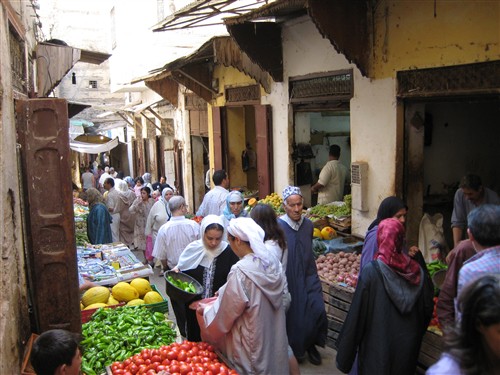
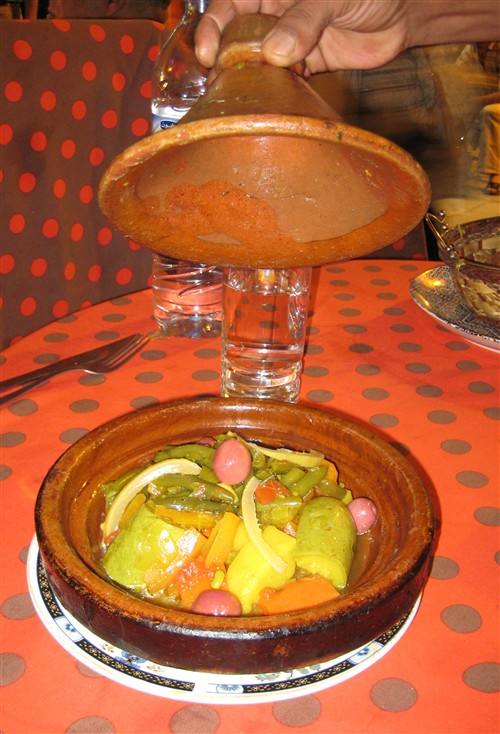 As we watched the crowds of locals and tourists shuffle through the medina, our attention was drawn to the occasional provocatively dressed European tourist – they stick out like a sore thumb among the modest jellaba-clad locals – and I was reminded of a conversation that we had had in Marrakech regarding the differences between Moroccans and Egyptians. I noted the gentle nature, the lighthearted smiles, and the seeming acceptance of Westerners by Moroccans in stark contrast to the Egyptians with their suspicious, judgmental eyes and fierce cunning. Aaron suggested that perhaps we (our perspectives, that is) are different after a year of travel, a notion I dismissed initially but now reflected upon as I studied the uncomfortable looks of the naïve young women with heaving cleavage, only vaguely aware of their effect on the ravenous, sexually repressed pack of wolves lurking in the shadows. I gazed upon the bouncing bosoms, spaghetti straps, and short skirts, asking the flesh-bearers telepathically, Look around you. Why would you wear that?
As we watched the crowds of locals and tourists shuffle through the medina, our attention was drawn to the occasional provocatively dressed European tourist – they stick out like a sore thumb among the modest jellaba-clad locals – and I was reminded of a conversation that we had had in Marrakech regarding the differences between Moroccans and Egyptians. I noted the gentle nature, the lighthearted smiles, and the seeming acceptance of Westerners by Moroccans in stark contrast to the Egyptians with their suspicious, judgmental eyes and fierce cunning. Aaron suggested that perhaps we (our perspectives, that is) are different after a year of travel, a notion I dismissed initially but now reflected upon as I studied the uncomfortable looks of the naïve young women with heaving cleavage, only vaguely aware of their effect on the ravenous, sexually repressed pack of wolves lurking in the shadows. I gazed upon the bouncing bosoms, spaghetti straps, and short skirts, asking the flesh-bearers telepathically, Look around you. Why would you wear that?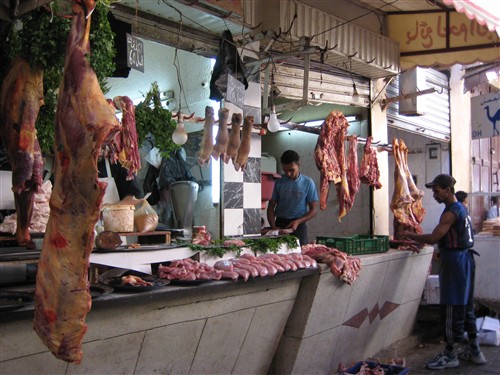 By the time we arrived in Fes, the atmosphere of the medina, with its mosques and medersas, had lost a bit of its luster. While we engaged in the requisite aimless wandering, we found ourselves seeking quiet refuge from the hustle and intensity of the streets. When you have the sponge-like desire for the sensory overload of Third World culture, the Moroccan medina delivers an explosion of colorful produce stalls, freshly butchered carcasses hanging in shop fronts, enchanting Arabic music, donkey carts, street hustlers, savvy rug dealers, burqa-clad women peering out through their narrow eye-slits, the constant engagement of shopowners beckoning you inside for a look, dark clandestine corners, aromas of fresh mint and cilantro filling the air…all in a buzzing kaleidoscope of stimulation. Even the sidewalk cafés are fair game for amateur tour guides, beggars and street performers. When you are weary of the chaos, you must find oases on elevated terraces, in high-end hotels and quiet internet cafés.
By the time we arrived in Fes, the atmosphere of the medina, with its mosques and medersas, had lost a bit of its luster. While we engaged in the requisite aimless wandering, we found ourselves seeking quiet refuge from the hustle and intensity of the streets. When you have the sponge-like desire for the sensory overload of Third World culture, the Moroccan medina delivers an explosion of colorful produce stalls, freshly butchered carcasses hanging in shop fronts, enchanting Arabic music, donkey carts, street hustlers, savvy rug dealers, burqa-clad women peering out through their narrow eye-slits, the constant engagement of shopowners beckoning you inside for a look, dark clandestine corners, aromas of fresh mint and cilantro filling the air…all in a buzzing kaleidoscope of stimulation. Even the sidewalk cafés are fair game for amateur tour guides, beggars and street performers. When you are weary of the chaos, you must find oases on elevated terraces, in high-end hotels and quiet internet cafés.